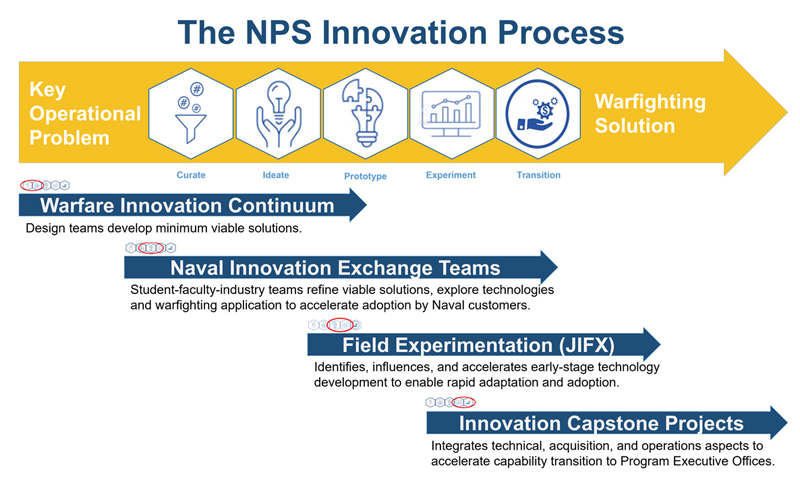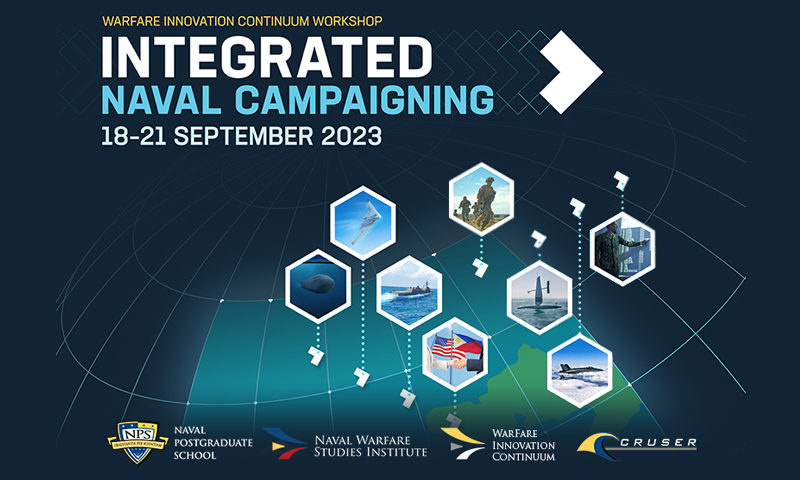In today’s era of strategic competition, the U.S. Navy and Marine Corps understand that innovation is a key to success in the maritime warfighting domain.
To that end, every year the Naval Postgraduate School (NPS) brings together representatives from the fleet, service headquarters, the Naval Research and Development Establishment, and industry to work with NPS students and faculty at the Warfare Innovation Continuum (WIC) Workshop, one of the pillars of the NPS innovation process.
This year’s WIC Workshop, which ran from Sept. 18-21, centered on “Integrated Naval Campaigning,” with participants attending panel discussions and working in teams to generate innovative solutions to challenges related to that theme.
The event is coordinated and supported by NPS’ Naval Warfare Studies Institute (NWSI) as part of its efforts to connect NPS faculty and students across campus and beyond to challenges faced by naval forces. Retired U.S. Navy Capt. Jeff Kline, an NPS professor of practice who leads the year-long WIC campaign of analysis, was encouraged by the participation and success of this year’s event.
“NPS has been hosting an annual Warfare Innovation Workshop for over 13 years,” said Kline. “With over 100 individuals attending from warfare labs, industry, warfare development centers, fleet staffs, the Pentagon, and our own faculty and students, we obtain a diverse set of technical, engineering, and operational talent to generate concepts for employing emerging and existing technologies in operational environments.”
In addition to 108 active participants, the WIC Workshop had an additional 73 registered observers. International participants from Australia, Taiwan, Brazil, Indonesia, Turkey, South Korea, Singapore, India, and Colombia added depth and diversity of expertise, experience, and perspectives and greatly enhanced the team dynamics.
Before breaking into teams, participants attended panel discussions on the WIC Workshop theme and the NPS innovation process. Rear Adm. Richard Seif, Commander, Submarine Force, U.S. Pacific Fleet (COMSUBPAC), spoke on the first panel of the event that introduced the workshop’s theme.
"It was great to take part in this conversation about Integrated Naval Campaigning with the WIC participants,” Seif said. “Across the U.S. Navy, and particularly within the Submarine Force, we are thinking about how technology will affect how we employ our forces in the future. It's vitally important that we use these conversations as opportunities to discuss these possibilities and challenges. It is inspiring to see how collaboration between warfare communities, countries, and generations comes together at this workshop to push the boundaries of how we think about operations within the maritime domain."
At the end of the first day, participants divided into their groups. Each group examined the intersection of technology and warfighting within their topic. During the next three days, eight concept generation teams – Amphibious Ops, Gray Zone Ops, Coalitions Ops, Undersea Ops, Advanced Mining, Contested Logistics, Long Range Fires, and Future VTOL – were guided by experienced mentors and facilitators through a rapid concept generation process.
The last day of the event was dedicated to team presentations and evaluations. Each team provided a brief on their topic that outlined areas of concern and then new strategies or technologies that addressed that concern. They responded to questions from the audience and defended their solutions.
Among the international attendees was Indonesian Navy Lt. Rayhan Khar, an NPS student who was part of the Maritime Gray Zone Operation working group.
“Our Gray Zone Operation team is not only talking about how world powers compete, but also how partnerships and alliances will impact a situation,” said Khar, who is currently studying Information Strategy and Political Warfare in the NPS Department of Defense Analysis. “We are working with institutions like Johns Hopkins University and Lockheed Martin to have an open-minded discussion. Our team is asking how we can do an operation with perspectives from scholars, historians, and anthropologists along with military institutions.
“This is a good time to enhance cooperation between countries to maintain freedom of navigation in the Indo Asia-Pacific and maintain the peace of Eurasia,” Khar added. “Together, we can build a framework where a great operation avoids escalation into a real conflict.”
The diverse community was noted by other participants as well. Robert Zebrowski, a senior researcher at the Johns Hopkins University Applied Physics Laboratory (JHU APL), graduated from NPS in 2011 and was excited to return to take part in the Gray Zone Operations team. He and other representatives from JHU APL are taking their experience with WIC to heart and looking for ways to incorporate concepts from the workshop into their jobs.
“I'm in the reserves now, but from my day job I support the Submarine Force. I analyze the combat control system, check the algorithms, and see what the operator employment of the system is,” said Zebrowski. “This event took me out of what I do on a daily basis. It was a lot more of an open thinking, ideological approach. At my work, we often think about being a bridge between business and industry, so this has opened us to an academic perspective.”
The final concepts presented by the eight teams, outlined in this initial report, will be leveraged to inform areas of research, and in developing potential solutions to move forward in the NPS innovation process.
“We synthesize ideas from the various innovation teams to further develop in the year-long warfare innovation continuum, provide candidates for the Naval Innovation Exchange teams, suggest prototypes to test in the NPS field experimentation programs, and later have acquisition strategies developed in our NPS Innovation Capstone Projects,” said Kline. “But the real value is the connections made at the workshop between participants. Junior officers exchange ideas with industry and navy lab engineers. These connections provide the basis for career networking to possibly address future challenges beyond the WIC Workshop.”
NPS has defined an innovation continuum that channels concepts through a six-step process: source, curate, ideate, prototype, experiment, and transition. Programs like the WIC Workshop serve to put diverse groups together in one space so ideas can be generated that make sense from both a research perspective and a warfighting need.

The NPS Office of Research and Innovation (OR&I) has been working to streamline the innovation continuum and ensure there is support for each step of the innovation process. Kaitie Penry, Director of Research Innovation within OR&I, sees the WIC Workshop as a key contributor to the curation and ideation components.
“The WIC Workshop really forms that first touch point of, ‘What is it that we're looking at?’” said Penry. “It comes in after we've been able to source meaningful projects from the Fleet and Fleet Marine Force, OPNAV, ONR, or any similar stakeholder. It provides a space for us to put our thoughts into manageable bites that can then have actual solutions developed against them.”
NPS has historically been a place where warfighting and research combine to create unique military solutions. As the school looks to cement the concept of the Naval Innovation Center at NPS, the WIC Workshop and similar events will form a foundational block of what happens at the center and what NPS provides back to the Navy.


